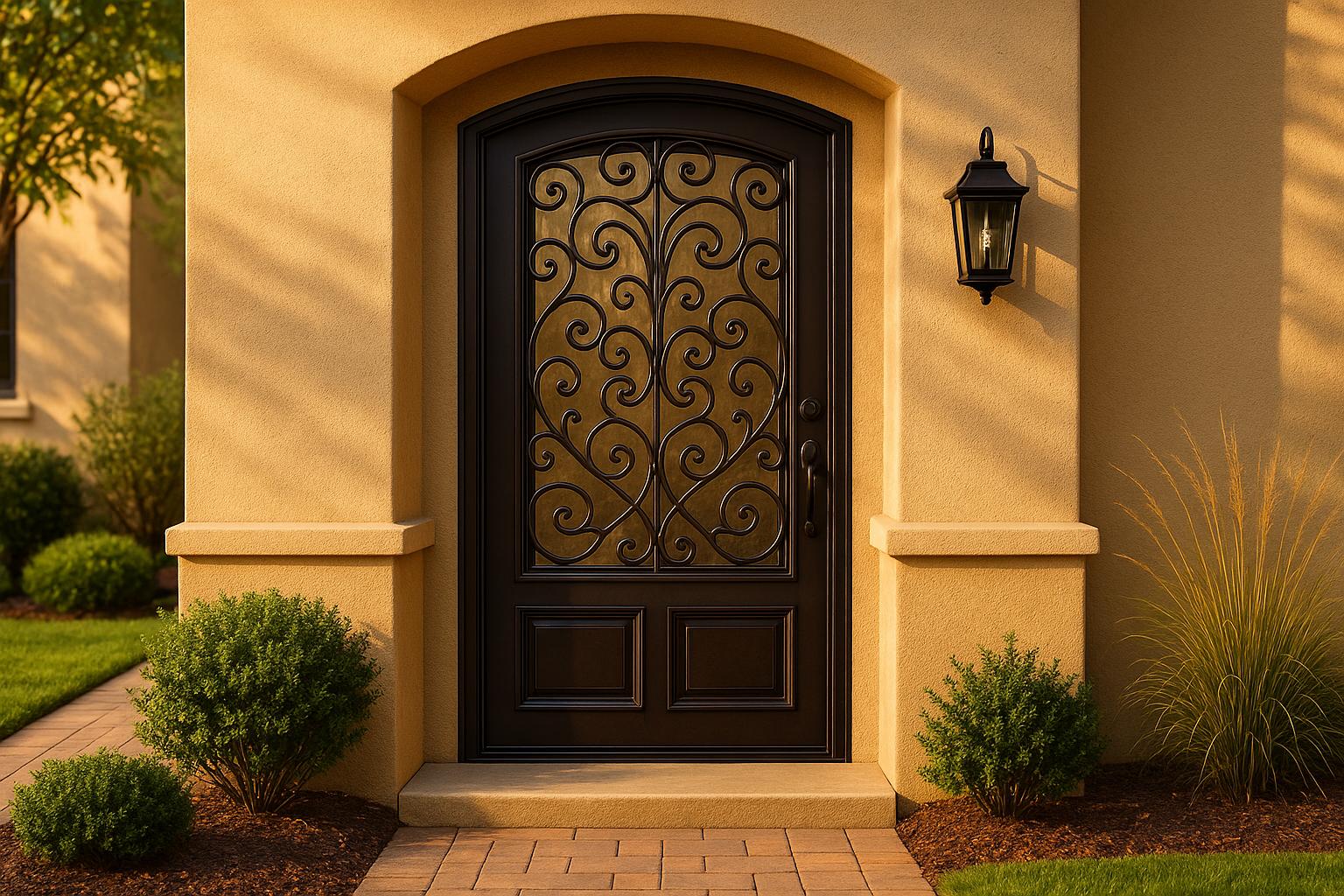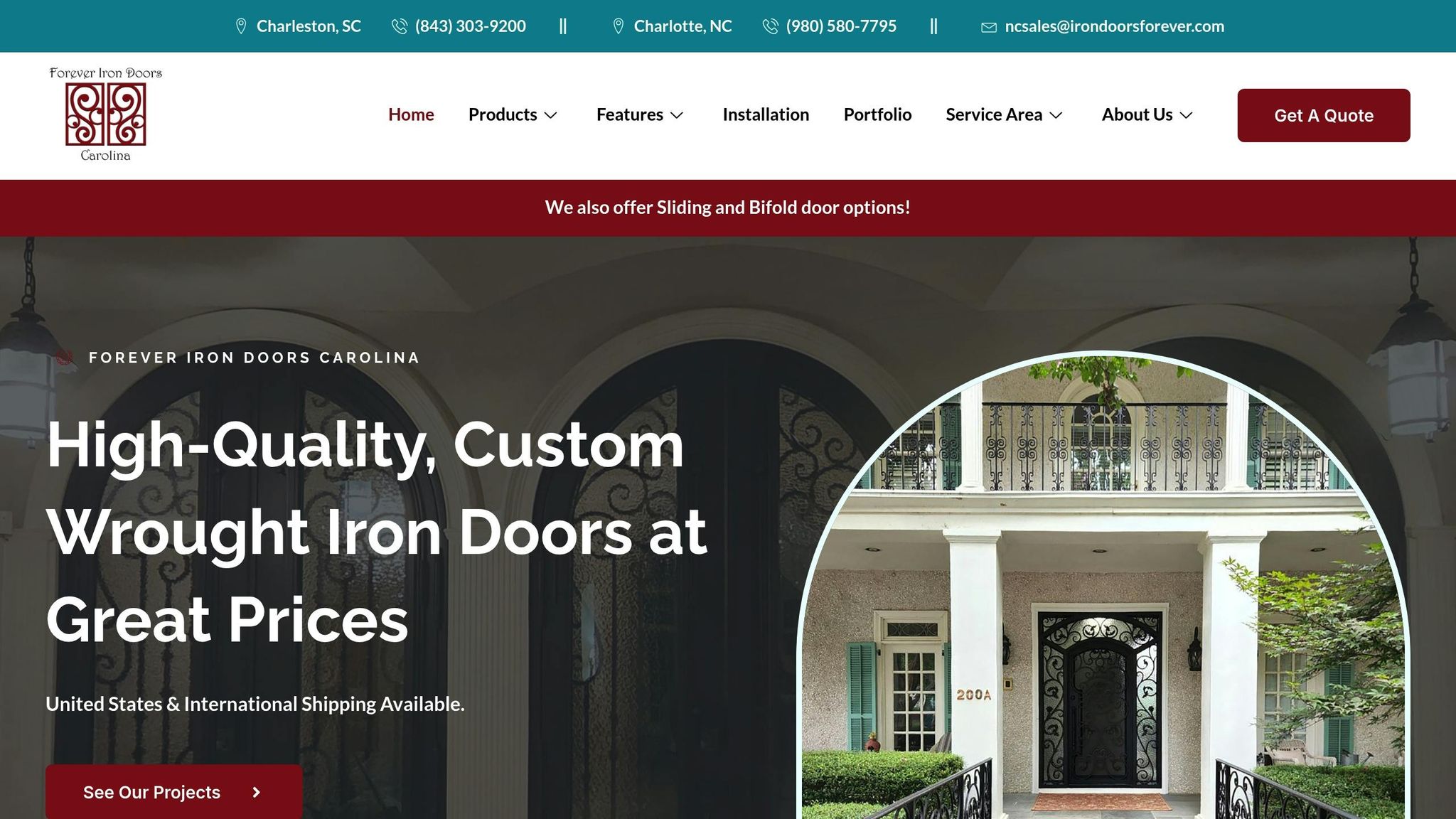Maintaining your wrought iron door is essential to keep it functional, secure, and long-lasting. With proper care, these doors can last 30 to 100 years or more. Neglecting maintenance leads to rust, mechanical issues, and costly repairs, while consistent upkeep prevents damage and saves money over time. Here’s a quick summary of what you need to know:
- Key Maintenance Steps:
- Clean monthly with mild soap and water; dry thoroughly.
- Inspect for rust, chips, or loose hardware regularly.
- Lubricate hinges and locks twice a year with silicone or graphite-based products.
- Apply protective coatings every 1-3 years (more often in humid or coastal areas).
- Risks of Neglect:
- Rust weakens the structure and spreads quickly.
- Hinges and locks may fail, compromising security.
- Damaged finishes hurt curb appeal and property value.
- Repairs or replacements can cost hundreds to thousands.
- Tips for Harsh Climates:
- Clean every two weeks in coastal or high-humidity areas.
- Use marine-grade paint or powder coatings for added protection.
- Inspect after storms to address early signs of damage.
Regular care is the key to preserving your investment. By following these steps, your iron door can remain beautiful, secure, and functional for decades.
Problems Caused by Poor Maintenance
Skipping regular upkeep doesn’t just dull the look of a wrought iron door – it can also weaken its structure, disrupt its functionality, and compromise its security. Let’s explore how neglect in key areas can shorten your door’s lifespan.
Rust and Corrosion
A small scratch or chip in the coating may not seem like a big deal, but it exposes the iron beneath to moisture and oxygen. This triggers rust, which slowly eats away at the metal and leaves visible damage. If you live near the coast, the salt in the air can speed up this process significantly. Some homeowners in these areas notice severe corrosion in just a few years, while a well-maintained door could last over 30 years. High humidity also encourages rust, especially in vulnerable spots like corners and joints.
Dirt Buildup and Surface Damage
Dust and dirt might seem harmless, but they trap moisture against the surface. Over time, abrasive particles can scratch the protective coating, especially in detailed designs with tight crevices. This constant wear and tear weakens the door’s defenses, leaving it more vulnerable to further damage.
Worn Hinges and Locks
Without proper lubrication, hinges and locks can become stiff or misaligned. This adds unnecessary strain on the door’s frame and can even compromise its security. Left unchecked, these small mechanical issues can snowball into complete hardware failure.
Weather Damage
Extreme weather takes a toll on wrought iron doors. Harsh conditions can chip paint and degrade sealants, allowing moisture to seep in. Over time, the cycle of expansion and contraction from temperature changes weakens the door’s protective layers. In colder climates, snow and ice buildup around hinges can cause corrosion and further damage. These weather effects often compound the harm caused by dirt, rust, and mechanical neglect.
Key Maintenance Steps for Iron Doors
Now that you’re aware of the potential problems that can arise without proper care, let’s dive into the steps that will help your wrought iron door stay in top shape – both in appearance and functionality – for years to come.
Regular Cleaning and Drying
Keeping your door clean is a must. Use a soft cloth or sponge with warm water and mild soap to gently remove dirt and debris from the surface.
After cleaning or exposure to rain, make sure to dry the door completely. This simple step helps prevent water spots and rust from forming.
Stick to non-abrasive, metal-safe cleaners, and steer clear of harsh chemicals or abrasive tools – they can damage the protective finish and leave your door vulnerable to wear.
Monthly Inspections
Taking a few minutes each month to inspect your door can save you from bigger headaches down the line. Look closely for early signs of trouble like rust spots, paint chips, or loose hardware.
Pay special attention to corners, welds, and hinges, as these areas are more prone to wear and tear.
Rust Removal and Touch-Ups
If you spot rust during your inspection, don’t wait – address it right away. Use fine steel wool or sandpaper to gently remove the rust, then apply a rust-resistant primer followed by matching exterior paint. Make sure the surface is clean and dry before painting to ensure lasting results.
Applying Protective Coatings
Once you’ve dealt with rust, applying a protective coating adds an extra layer of defense. These coatings act as a shield against the elements. Depending on your local climate, reapply rust-proof paint or sealant every one to three years. If you’re in a humid area or near the coast, consider doing this annually to combat the effects of salt air and moisture.
For a more durable option, a powder coating is worth considering. This professional-grade finish offers better protection and fade resistance than standard paint, and it comes in a variety of colors like matte black, bronze, and charcoal.
Lubricating Moving Parts
Twice a year, give your door’s hinges and locks some attention. Use a silicone-based or graphite lubricant, as these won’t attract dust and grime like oil-based products often do.
If you notice squeaking or stiffness, apply lubricant to all moving parts right away. Regular lubrication not only keeps things operating smoothly but also helps prevent rust at metal-to-metal contact points, extending the life of your door’s hardware.
Solving Common Maintenance Problems
Maintaining a wrought iron door can be a bit of a challenge, especially when you’re dealing with intricate designs or harsh environmental conditions. Even with the best care, issues can arise. Here’s how to tackle common maintenance concerns and keep your door in top shape for years to come.
Cleaning Detailed Designs
The ornate scrollwork and intricate patterns that make wrought iron doors so appealing can also make them tricky to clean. Dust and grime love to settle into those tight crevices, and standard cleaning tools often fall short.
To get the job done right, use soft-bristled brushes. An old toothbrush or an artist’s brush works wonders for detailed scrollwork, while a slightly larger brush is ideal for broader decorative elements. Start by wiping down the door with a soft cloth to remove loose dust. Then, dip your brush in a mild soap-and-water solution and gently clean the detailed areas.
Once you’ve finished, make sure to dry the door completely, especially in the crevices, to prevent moisture from lingering and causing rust.
Picking the Right Products
Using the wrong cleaning products can do more harm than good. Certain cleaners can strip protective coatings or speed up corrosion, so it’s important to choose wisely.
Stick to mild, non-abrasive soaps or detergents mixed with warm water for regular cleaning. For added protection, look for rust-inhibiting primers, paints, and clear sealants specifically made for metal surfaces. These products help preserve the door’s finish without altering its appearance.
If you’re unsure, check with your door manufacturer. For example, Forever Iron Doors Carolina provides detailed maintenance guidance, including recommended cleaning products and touch-up kits tailored to their doors.
Maintenance in Harsh Climates
Living in a coastal area or a humid environment? Your wrought iron door will need extra attention. Salt air and constant moisture can speed up corrosion, so regular maintenance becomes even more crucial.
In these conditions, clean your door every two weeks instead of monthly. This helps remove salt, moisture, and debris before they cause damage. After heavy rain or storms, take a moment to dry the door and inspect it for early signs of rust.
For extra protection, consider upgrading to marine-grade paint or powder coatings. These provide a stronger barrier against the elements. Adding weather seals around the door frame can also help keep moisture at bay.
| Climate Type | Cleaning Frequency | Protective Coating Schedule | Notes |
|---|---|---|---|
| Standard | Monthly | Every 1-2 years | Regular inspection |
| Coastal/High Humidity | Every 2 weeks | Every 6-12 months | Use marine-grade products, check after storms |
| Extreme Weather | Bi-weekly | Every 6 months | Install weather seals, address damage quickly |
Fixing Damage Quickly
Scratches, chips, and small dents are inevitable over time, but addressing them right away can prevent bigger problems down the line. Quick repairs stop moisture from seeping in, which helps avoid rust and corrosion.
For minor issues, clean the area thoroughly and lightly sand it to remove any rust. Apply a rust-inhibiting primer made for metal surfaces, then follow up with touch-up paint that matches your door’s finish. Always ensure the surface is completely clean and dry before applying primer or paint, and let each layer cure fully before adding the next.
For deeper dents or structural damage, it’s best to call in a professional. DIY fixes on major issues can sometimes worsen the problem or compromise the door’s integrity.
sbb-itb-cd90297
How Forever Iron Doors Carolina Builds Long-Lasting Doors
Keeping your iron door in great shape starts with proper maintenance, but the secret to real durability lies in how it’s designed and built. Forever Iron Doors Carolina takes a thoughtful approach to crafting doors that can handle the unique climate challenges of North and South Carolina. From selecting top-notch materials to ensuring expert installation and offering ongoing support, they build doors meant to last.
Quality Materials and Protective Finishes
It all begins with the materials. Forever Iron Doors Carolina uses 14-gauge (or thicker) wrought iron, known for its strength and ability to resist warping, cracking, and damage from the elements. This heavy-duty iron forms the backbone of doors built to endure years of daily use and weather exposure.
But durable iron alone isn’t enough. The company applies advanced weather-resistant coatings for added protection. Their multi-step powder coating process creates a tough, fade-resistant finish that stands up to harsh conditions. With options like matte black, bronze, charcoal, or custom colors, these finishes not only look great but also provide an extra layer of defense against the elements.
For homes in coastal or high-humidity areas, marine-grade coatings offer additional protection, reducing the need for frequent maintenance by shielding the door from salt air and moisture.
Custom Design and Professional Installation
A door’s longevity depends heavily on its fit. Forever Iron Doors Carolina customizes each door to match the exact dimensions of its opening, ensuring a snug fit that prevents water intrusion and operational issues. This precise fit helps minimize potential maintenance headaches down the line.
Their installation process is more than just hanging a door. The team carefully inspects your home’s framing to confirm it’s structurally sound and ensures the door is level and operates seamlessly.
"We want to make sure your home’s framing is structurally sound and your new iron door is level and operating smoothly. We’ll also make sure that the molding and caulk is applied professionally and in proper working order."
This meticulous attention to detail helps avoid common problems like sagging hinges, sticking doors, or failed weather seals, which can all lead to premature wear. The installation team, made up of certified installers and master carpenters, understands how to align and seal doors for long-term performance.
Customers frequently praise this level of professionalism. Matt V. shared:
"Very professional in every aspect. Cory and his install team were fantastic and did an incredible job."
Maintenance Guidance and Support
Forever Iron Doors Carolina doesn’t just install your door and leave you to figure out the rest. They provide ongoing support to help you keep your door in top condition. Their maintenance instructions are tailored to the Carolinas’ specific climate, offering advice on cleaning schedules and the best products to use.
The company goes a step further with educational resources that teach homeowners how to care for their doors. For example, in October 2025, they published guidance like "Common Faux Painting Problems and Solutions", offering practical tips on everything from surface prep to touch-ups to maintain a flawless finish.
This proactive effort empowers homeowners to address minor issues before they escalate into costly repairs. With advice designed to handle the region’s humidity, temperature swings, and seasonal weather, Forever Iron Doors Carolina makes it easier to protect your investment. Their expertise ensures your door stays durable and beautiful for years to come.
Conclusion: Protect Your Iron Door Investment
Taking care of your iron door isn’t just about keeping it functional – it’s about preserving an investment that enhances your home’s security, curb appeal, and overall value.
With proper maintenance, a wrought iron door can last over 30 years, making it a durable and worthwhile addition to your home. By following the steps outlined earlier – like regular cleaning, prompt touch-ups, and routine inspections – you can avoid expensive repairs or even the need for a full replacement. Homeowners in tough climates have shown that these practices can keep iron doors looking pristine, even after years of exposure to harsh weather.
Rust is your door’s biggest enemy, so addressing any spots immediately with touch-up paint can save you from more extensive damage. If you live in coastal areas, where salt in the air speeds up corrosion, experts suggest cleaning your door every two weeks and applying a protective sealant every 6–12 months to keep rust at bay.
By sticking to a maintenance routine, you’ll not only extend the life of your door but also enhance its security and keep repair costs to a minimum. Whether you’re caring for a newly installed door or restoring an older one, the approach is the same: stay consistent, use the right materials, handle issues promptly, and don’t hesitate to consult professionals when necessary.
Your iron door is built to endure. With regular care, you’ll ensure it stays beautiful and secure for decades to come.
FAQs
How often should I clean and inspect my wrought iron door to keep it in great condition?
To keep your wrought iron door looking great and standing strong, make it a habit to clean and inspect it every 3 to 6 months. Regular cleaning gets rid of dirt, debris, and moisture that might cause rust, while inspections help you spot issues like scratches, chips, or early signs of corrosion before they become bigger problems.
When cleaning, stick to a mild soap and water solution and use a soft cloth or sponge. Steer clear of abrasive materials that might scratch or damage the finish. During inspections, look closely for rust spots or any damage to the paint or sealant, and handle these issues right away to avoid further wear and tear. These small but consistent efforts can go a long way in preserving your iron door’s durability and keeping it as a beautiful feature for years to come.
What is the best way to lubricate the hinges and locks on a wrought iron door?
To ensure your wrought iron door continues to work seamlessly, make it a habit to lubricate its hinges and locks regularly. For the hinges, opt for a silicone-based lubricant or a light machine oil – both are excellent for minimizing friction and preventing rust. When it comes to the locks, a dry graphite lubricant is your best bet since it won’t collect dust or debris, keeping the mechanism smooth and functional over time.
Remember to apply the lubricant sparingly and wipe off any excess to prevent buildup. Simple upkeep like this not only keeps your door functioning effortlessly but also adds years to its life.
How can I protect my wrought iron door from damage caused by coastal salt air or high humidity?
To keep your wrought iron door looking its best and standing strong against coastal salt air or high humidity, regular upkeep is essential. Start by washing the door with a mix of mild soap and water to clear away any salt or grime that may have accumulated. Once cleaned, make sure the door is completely dry – leaving moisture behind can lead to rust.
Adding a protective sealant or rust-resistant coating is another effective way to guard against corrosion. In areas with severe weather, applying wax to the surface now and then can provide an extra layer of defense. Make it a habit to inspect the door regularly for any signs of rust or damage, and take care of issues quickly to keep them from escalating.
For those in search of sturdy, custom wrought iron doors built to handle tough conditions, Forever Iron Doors Carolina provides high-quality options. Their doors are designed with both durability and elegance in mind, ensuring they remain beautiful and functional for years to come.




